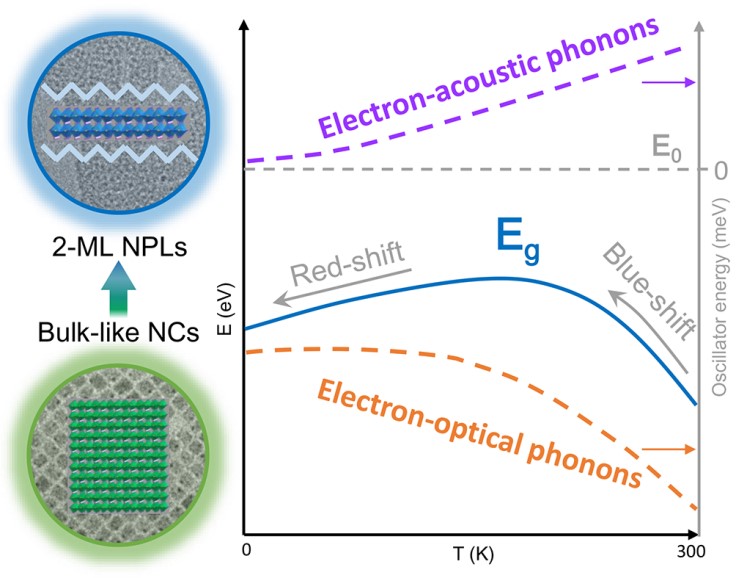Owing to the high quantum yields, large absorption cross-section, excellent carrier transport performance and narrow-band emission, inorganic lead-halide perovskite semiconductors have received considerable attentions for applications in solar cells, LEDs, and laser devices, etc. Understanding the physical origin of temperature dependence of bandgap in inorganic lead-halide perovskites is essential and important in terms of their optical and optoelectric properties.
In a recent study published in Adv. Sci., the research group led by Prof. CHEN Xueyuan from Fujian Institute of Research on the Structure of Matter (FJIRSM) of the Chinese Academy of Sciences (CAS) found that the temperature dependence of bandgap in CsPbBr3 perovskites is variable with material dimensionality.
The researchers conducted a comparative investigation on the temperature-dependent bandgap in quasi-3D bulk-like CsPbBr3 nanocrystals (NCs) with weak quantum confinement and 2D 2-monolayer-thick CsPbBr3 nanoplatelets (2-ML NPLs) featuring strong quantum confinement.
For the sake of more accurate determination of bandgap shift, the researchers elaborately extracted the bandgap energy through fitting the absorption coefficient near the band edge to the Elliot model. The extracted bandgap value of CsPbBr3 2-ML NPLs exhibited an initial blueshift then redshift trend with decreasing temperature from 290 to 10 K, in sharp contrast to the monotonous redshift usually observed in CsPbBr3 bulk-like NCs.
From the theoretical point of view, the bandgap renormalization essentially arises from the lattice thermal expansion and electron-phonon interactions. However, for a large variety of semiconductor materials and in particular the lead-based compounds, the thermal expansion contribution to bandgap renormalization was not taken into account because it had a relatively small magnitude with respect to the contribution from electron-phonon interactions.
Essentially, owing to the breaking translational periodicity in the thickness direction of 2D CsPbBr3 2-ML NPLs, the electron and phonon structures, and consequently the bandgap renormalization deriving from electron-phonon interactions are apt to change remarkably relative to the quasi-3D CsPbBr3 NCs counterparts.
In addition, the strong quantum confinement effect and the reduced dielectric screening due to the low dielectric constant of surface organic ligands in CsPbBr3 2-ML NPLs also influence the electron-phonon interactions.
To reinforce this hypothesis, the researchers adopted the Bose-Einstein two-oscillator model to determine the effective electron-phonon interaction coefficient through fitting the bandgap as a function of temperature, the results of which manifest that the significantly larger weight of contribution from electron-optical phonon interaction to bandgap renormalization in the NPLs than in the NCs accounts for the blueshift-redshift crossover of bandgap in NPLs.
The findings in this study provide new insights into the pivotal role of electron-phonon interactions in the bandgap renormalization for 2D inorganic lead-halide perovskites, which may pave the way for further investigations into the optical and optoelectronic properties of 2D perovskite nanomaterials.

Schematic illustration of the unusual blueshift-redshift crossover of bandgap with temperature in CsPbBr3 2-ML NPLs, which is tentatively attributed to the trade-off between the opposite contributions of electron-acoustic phonon and electron-optical phonon interactions to the bandgap renormalization. (Image by Prof. CHEN’s Group)
Contact:
Prof. CHEN Xueyuan
Fujian Institute of Research on the Structure of Matter
Chinese Academy of Sciences
Email: xchen@fjirsm.ac.cn